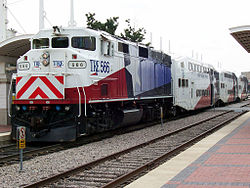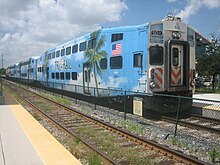Bombardier BiLevel Coach: Difference between revisions
Rescuing 4 sources and tagging 1 as dead. #IABot (v1.2.6) |
Rescuing 1 sources and tagging 0 as dead. #IABot (v1.2.7.1) |
||
| Line 150: | Line 150: | ||
| [[Greater Los Angeles Area]], [[California]] |
| [[Greater Los Angeles Area]], [[California]] |
||
|align=right| {{sort|147|147 cars}} |
|align=right| {{sort|147|147 cars}} |
||
|<ref>[http://www.rapidtransit-press.com/metrolink.html Metrolink Roster]</ref><ref>[http://209.79.237.36/about/Intranet/equipment.asp Equipment]</ref> |
|<ref>[http://www.rapidtransit-press.com/metrolink.html Metrolink Roster]</ref><ref>[http://209.79.237.36/about/Intranet/equipment.asp Equipment] {{wayback|url=http://209.79.237.36/about/Intranet/equipment.asp |date=20090422063325 }}</ref> |
||
|- |
|- |
||
| [[Northstar Line]] |
| [[Northstar Line]] |
||
Revision as of 21:48, 12 November 2016
| Bi-Level Coach and Cab Car | |
|---|---|
 | |
| Manufacturer | Hawker Siddeley Canada-SNC Lavalin (Canadian Car and Foundry or Can Car) and UTDC-SNC Lavalin (Can Car), Bombardier Transportation |
| Built at | Fort William (Thunder Bay), Ontario |
| Constructed | 1976–Present |
| Entered service | 1976 |
| Capacity | 136 to 162 (seated); 142 in IV series, 276 standees |
| Operators | see article |
| Specifications | |
| Car body construction | Riveted or welded aluminum body on a steel frame |
| Car length | 85 ft (25.91 m) |
| Width | 9 ft 10 in (3.00 m) |
| Height | 15 ft 11 in (4.85 m) |
| Doors | Pneumatically-operated doors |
| Weight | 50,000 kg (110,000 lb) |
| Power supply | 480 or 575 V HEP |
| Braking system(s) | Pneumatic tread brakes and disc brakes |
Bombardier BiLevel coaches are bilevel passenger cars designed to carry up to 360 passengers for commuter railways. These carriages are easily identifiable; they are double-decked and are shaped like elongated octagons.
History

The BiLevel coaches were designed by Toronto's regional commuter rail service, GO Transit and Hawker Siddeley Canada in the mid-1970s as a more efficient replacement for GO's original single-deck coaches and cab cars.[1] Later coaches were manufactured by Urban Transportation Development Corporation/Can-Car and finally Bombardier, who now owns the designs and manufacturing facility. There are more than seven hundred such coaches in service today and almost all have been built at the company's Thunder Bay, Ontario, and Plattsburgh, New York plants.

Construction
The coaches feature a riveted aluminum body on a steel frame. They are 15 ft 11 in (4.85 m) high and 9 ft 10 in (3.00 m) wide, and weigh about 61,000 kg (134,000 lb).[2] Depending on car design and seating configuration, seats are available for between 136 and 162 passengers, along with standing room. All newly built coaches now feature a washroom on the lower level; the original coaches for GO Transit have the washroom on the intermediate level in the same location where the cab is located in cab cars (see below). The coaches have two pairs of doors on each side which allow the entire coach to be emptied in 90 seconds. Some of the newer coaches have electrical outlets for laptop computers and other devices along with small tables.

One major variant is the cab car. The cab car is placed at the end of the train and features a full cab built into the end of the coach, from which the train's locomotive can be remotely controlled. This allows for push–pull operation with a faster turnaround time for trains, by avoiding having to physically turn around the train or locomotive. Unlike the similar Driving Van Trailer used by Britain's InterCity 225, the cab cars are otherwise identical to the regular coaches rather than imitating the design of the locomotive, leading to the appearance that the train is travelling 'backwards'. In 2014 Metrolinx (the provincial agency operating GO Transit) and Bombardier announced a new design for the cab car, which included a larger cab end and crash-energy management crumple zones.[3]
Most of these coaches use a 480 volt head end power (HEP) system for heating, lighting, and air conditioning. The only exception to this is with GO Transit which uses a 575 volt system (575 volts is a standard industrial Canadian voltage, having been previously used by CN for their Tempo cars — also built by HS). Whenever GO has leased coaches to other agencies, a power unit has been supplied with the coaches, or when GO has leased coaches from other agencies, a locomotive with 480 volt HEP capabilities was also leased. Amtrak, Via Rail and the Agence métropolitaine de transport also use 480 volt HEP (480 volt is a standard industrial U.S. voltage).
Series
| Model | Operators | Notes |
|---|---|---|
| Bi-Level I coach | GO Transit,[4] Metrolink (Southern California) | originally built by HSC/Can Car |
| Bi-Level II coach | GO Transit, Metrolink, Trinity Railway Express, Coaster (San Diego) | originally built by HSC/Can Car |
| Bi-Level III coach | GO Transit, Metrolink, Tri-Rail, | originally built by UTDC/Can Car |
| Bi-Level IV coach | GO Transit | originally built by UTDC/Can Car |
| Bi-Level V coach | GO Transit | originally built by UTDC/Can Car |
| Bi-Level VI coach | GO Transit, West Coast Express (some leased to GO Transit), Sounder commuter rail, New Mexico Rail Runner Express, Altamont Commuter Express, Trinity Railway Express, Caltrain, Capitol Corridor | Built by Bombardier Transportation |
| Bi-Level VII coach | GO Transit,FrontRunner, Agence métropolitaine de transport, Northstar Commuter Rail, SunRail | Built by Bombardier Transportation |
| Bi-Level VIII coach | GO Transit, Sounder Commuter Rail, | Built by Bombardier Transportation |
Operators




Many commuter rail agencies have adopted the Bombardier BiLevel Coach for use in their fleets. They include:
| Operator | Location | Fleet size | Notes |
|---|---|---|---|
| Agence métropolitaine de transport | Montreal, Quebec | 22 cars | [5] |
| Altamont Commuter Express | San Jose, California | 24 cars | [6] |
| Caltrain | San Francisco, California | 41 cars | |
| Capitol Corridor | Sacramento, California | 138 cars | |
| Coaster | San Diego, California | 28 cars | [7][8] |
| FrontRunner | Salt Lake City, Utah | 22 cars | [9] |
| GO Transit | Greater Toronto Area, Ontario | 615 cars | [10] |
| Metrolink | Greater Los Angeles Area, California | 147 cars | [11][12] |
| Northstar Line | Minneapolis, Minnesota | 18 cars | |
| Rail Runner Express | Albuquerque, New Mexico | 22 cars | [13] |
| Sounder | Seattle, Washington | 58 cars | [14] |
| SunRail | Orlando, Florida | 20 cars | [15] |
| Tri-Rail | Miami/Fort Lauderdale/West Palm Beach, Florida | 26 cars | [8][16] |
| Trinity Railway Express | Dallas/Fort Worth, Texas | 17 cars | [8][17] |
| West Coast Express | Vancouver, British Columbia | 44 cars | [18] |
Similar units
Kawasaki also manufactures a similar product and it is used on diesel lines of the Long Island Rail Road, the MARC Train system in Maryland, MBTA Commuter Rail in the Boston area, and, formerly, Virginia Railway Express. VRE has since sold their cars to MARC. Bombardier's Görlitz, Germany plant manufactures another type of double deck train car, the Bombardier Double-deck Coach.
Bombardier has also designed and is manufacturing the MultiLevel coach for New Jersey Transit, MARC and the Montreal-area Agence Métropolitaine de Transport. This car is constructed of stainless steel similar to the Kawasaki cars purchased by the agencies listed above, but is built to a much tighter loading gauge, being only 14 feet 6 inches (4.42 m) tall.
List of rival coaches:
- Kawasaki L2 Double-Deck Coaches
- Kawasaki L3 Double-Deck Coaches
- Kawasaki MARC III Bi-Level coaches and cab cars
- Kawasaki CTC-4/BTC-4 series bi-level cars
- Hyundai Rotem BTC-5 bi-level train set
- Gallery cars (Numerous builders)
- Morrison-Knudsen 8000 series California Cars and Alstom 6000 series Surfliners for Amtrak California
- St. Louis Car Company and Nippon Sharyo Highliner cars
- Colorado Railcar (now US Railcar) DMU bi-level and bi-level trailer cars
See also
References
- ^ Bi-Level Coaches (1978-)
- ^ The Bi-level coaches
- ^ http://transit.toronto.on.ca/regional/2507.shtml
- ^ The Bi-level Coaches
- ^ AMT Current Fleet
- ^ Fleet Specifications[permanent dead link]
- ^ Bombardier receives bi-level commuter car order for the San Diego, California area
- ^ a b c Friends of SMART
- ^ FrontRunner on the front burner: Utah's new commuter rail system is expected to be a leading transportation option for the Salt Lake City region
- ^ http://www.gotransit.com/public/en/aboutus/QF_InfoToGo_EN_04-15.pdf
- ^ Metrolink Roster
- ^ Equipment Archived 2009-04-22 at the Wayback Machine
- ^ Bombardier Rolls Out First BiLevel Commuter Car for New Commuter Rail Line in New Mexico, USA
- ^ Sounder Archived 2008-09-16 at the Wayback Machine
- ^ http://www.webcitation.org/6SQI445fG?url=http%3A%2F%2Fwww.bizjournals.com%2Forlando%2Fblog%2F2013%2F07%2Ftheyre-here-first-sunrail-cab-car.html
- ^ Tri-Rail Commuter Train Archived 2008-03-19 at the Wayback Machine
- ^ Train Facts Archived 2012-02-05 at the Wayback Machine
- ^ Vancouver Regional Transit
